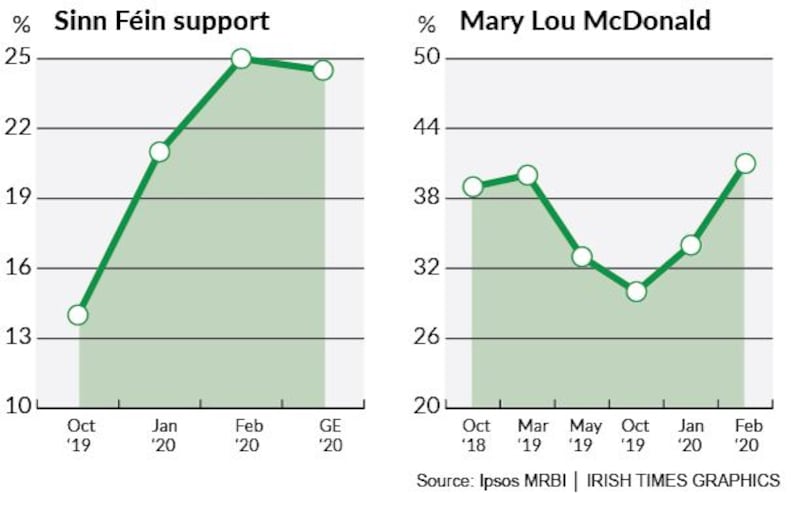Sinn Féin’s extraordinary success in last weekend’s election is the biggest disruption to the political duopoly that the State has ever experienced.
Some parallels may be drawn with the Spring Tide of 1992. However, what happened last Saturday is unprecedented. The result of the general election in 1992 saw the Labour Party merely close the gap with the two larger parties – both in terms of vote share and number of Dáil seats – albeit temporarily. This time is clearly different.
The greatest surprise is that Sinn Féin managed to deliver this success following an incredibly poor performance in last year’s local elections. Only a few months ago the general election looked like it could deliver a devastating blow to the party and its leadership. Instead the vote saw many of its candidates being elected with enormous surpluses, and some party members who had failed to hold council seats less than nine months previously were comfortably elected to the Dáil.

This remarkable turnaround has left many scratching their heads. How did it all happen so quickly?
The Ipsos MRBI/Irish Times series of opinion polls tracked the turnaround in Sinn Féin’s fortunes. These polls show that its vote share of 9.5 per cent in May’s local elections had risen to 14 per cent by October’s poll.
By the start of the general election campaign, it had risen further to 21 per cent. The party’s 24.5 per cent share of votes cast last Saturday matches the 25 per cent support Sinn Féin received in our final pre-election poll.
The turnaround in fortunes was evident for all to see; however, can the polls provide any clues as to why this happened?
Back in October, there was a general perception that the government was doing a good job, certainly in respect of two of the big issues of the day – Brexit and the economy. A majority (60 per cent) were satisfied with the way the government was handling the Brexit negotiations, and similarly a majority (54 per cent) felt it was doing a good job in managing the economy.
However, alongside these findings that poll also found that 32 per cent expected to be worse off as a result of the upcoming budget, with only 6 per cent expecting to be better off. A suggestion perhaps that the feeling for many was that while things may be improving generally, any personal benefit was more limited.
Dominant issues
We now know that Brexit and the economy were not dominant issues in the election campaign, and the initial strategy built by Fine Gael around these issues fell flat with voters. Instead, voters were more likely to be focused on immediate and personal concerns such as housing and health.
The exit poll conducted by Ipsos MRBI on behalf of The Irish Times, RTÉ, TG4 and UCD showed that 58 per cent of voters identified one of these two issues as being the most important factor in deciding their vote.
Among Sinn Féin voters this was higher still at 66 per cent. Sinn Féin had built strong messages around these key issues, which enabled it to highlight a significant difference between it and the traditional larger parties.
Sinn Féin was helped further by the dynamics of this particular campaign. Successful election campaigns are fought on the ground by local candidates and their canvassing teams, as well as by leaders on TV and radio and over social media. A winter campaign shifts the balance more towards the airwaves, as dark evenings make doorstep engagement by canvassing teams more challenging.
The limited extent of local engagement with all parties was noted by those participating in focus groups Ipsos MRBI undertook for The Irish Times during the campaign. As a result, voters paid more attention to leaders’ debates and other media events. Strong performances in these debates were more important than ever. Similarly, it was crucial to avoid campaign gaffes that could prove detrimental to a party’s fortunes.
The effect of this enhanced airwave battle shifted the focus even more towards the party leader. The exit poll found that 49 per cent of voters claimed that the party leader was very important to how they voted in the election. Among Sinn Féin voters it was even more important, with 61 per cent identifying Mary Lou McDonald as being very important to how they voted.
Leadership debates
It is widely considered that McDonald performed well in the various leadership debates, and internal analysis of our opinion poll data indicates that Sinn Féin received an uplift in support in the days following the leadership debate among seven party leaders on Virgin Media.

This was also reflected in her personal satisfaction ratings, which rose from 30 per cent at the start of the campaign to 41 per cent in the final pre-election poll. In contrast, personal satisfaction ratings for Fine Gael's Leo Varadkar and Fianna Fáil's Micheál Martin declined steadily during the same period, and both ended the campaign with 30 per cent satisfied with their performance.
These strong showings by Sinn Féin at a national level during the campaign undoubtedly influenced the way in which voters decided how to vote. When asked whether the local candidate or the party was more important to how they voted, 60 per cent of Sinn Féin voters identified the party as being more important. In contrast, the majority of those voting for Fianna Fáil and Fine Gael identified the local candidate as being more important.
Election campaigns matter a lot more than we often think. In fact, half of all voters claim that they only decide during the campaign who they are going to vote for, meaning that all was open to change during the 25 days of the recent campaign.
The campaign provided Sinn Féin with the opportunity to stand out in a more meaningful way and this translated into the seismic election result witnessed last weekend.
Kieran O’Leary is director of polling company Ipsos MRBI










